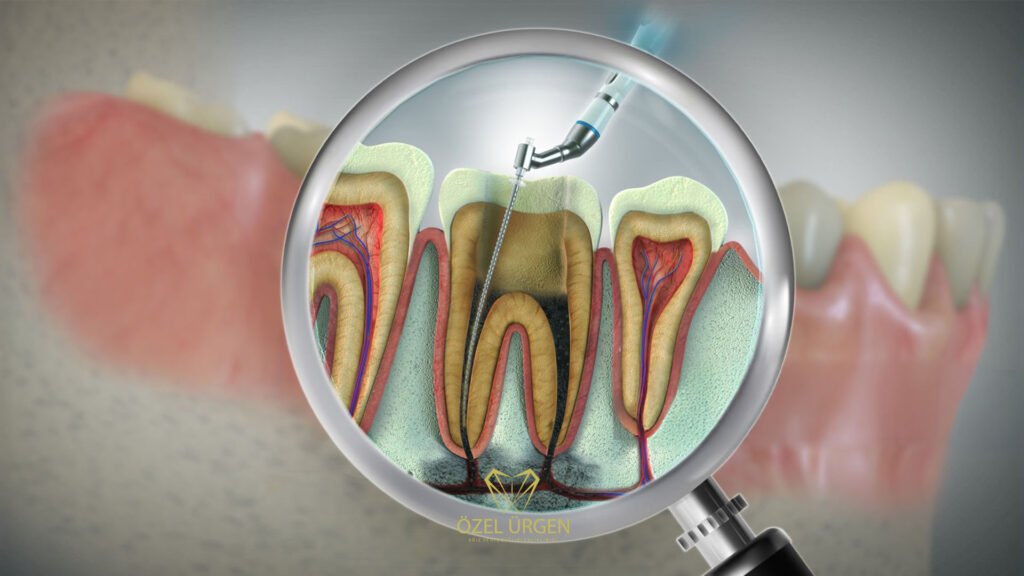- Mon - Fri 10:00 - 19:00
- Hacıhalil, Hükümet Cd. No : 80 Gebze/Kocaeli
- info@urgendis.com

When discussing dental health, one of the most critical treatments is undoubtedly root canal therapy. Many people have heard the term, but the details of the procedure are often unclear. Root canal therapy is one of the most frequently used and life-saving methods in dentistry to preserve a tooth rather than extract it. In cases of deep cavities, pulp inflammation, or trauma damaging the tooth’s internal tissue, many assume the only solution is extraction. However, modern dentistry allows the tooth to be saved and functionally maintained for many years through root canal treatment.
With advancements in technology and modern techniques, root canal therapy is no longer the long, painful, and intimidating procedure it once was. Today, when performed with the right diagnosis, techniques, and an experienced dentist, root canal therapy offers high success rates and patient comfort. Applied early, it preserves the natural tooth, allowing individuals to continue their daily lives healthily. Thus, root canal therapy not only saves a tooth but also maintains the overall health of the mouth and jaw.
Root canal therapy is a treatment applied when the innermost layer of the tooth, called the pulp, becomes inflamed or irreversibly damaged. The pulp contains nerves, blood vessels, and connective tissue that provide vitality and nourishment to the tooth. Deep cavities, trauma, old or insufficient fillings, or cracks in the tooth can lead to pulp infection. If left untreated, this infection threatens not only the tooth but also the surrounding tissues.
When the pulp is damaged, patients often experience severe pain, throbbing that wakes them at night, sensitivity to hot and cold, gum swelling, or abscess formation. Delaying treatment can allow the infection to reach the root tip and jawbone, potentially causing more severe complications beyond tooth loss, including jawbone infection.

During the root canal process, the infected or damaged pulp is carefully removed from the tooth. The root canals are then shaped and disinfected using specialized instruments. Finally, the empty canals are filled with biocompatible materials, allowing the tooth to regain its function. This preserves the tooth in the mouth, enabling the patient to continue using it both functionally and aesthetically.
Although historically considered a long and complex procedure, modern devices and techniques now allow root canal therapy to often be completed in a single, comfortable session. The process generally follows these steps:
At this stage, specialized endodontic instruments are used to shape the root canals and completely remove bacteria. If necessary, additional disinfection with antiseptic solutions ensures that the interior of the tooth is fully sterilized.

In the past, infected or inflamed teeth were often extracted. Today, thanks to root canal therapy, the natural tooth can be preserved without the need for extraction.
Removing a tooth not only disrupts chewing function but also creates aesthetic problems. The gap left by an extracted tooth can cause other teeth to shift and may lead to jaw joint issues over time. Therefore, preserving the natural tooth whenever possible is essential. Root canal therapy is the most effective alternative to extraction.
Many people immediately associate root canal therapy with pain. However, with modern dentistry and local anesthesia, patients do not feel pain during the procedure. Most patients report that the procedure is much more comfortable than they expected and comparable to a standard filling. Mild sensitivity may occur for a few days after treatment, but it quickly resolves, and the tooth remains healthy and functional.

Since the tooth is completely numbed during treatment, no pain is felt. However, mild soreness, tenderness while chewing, or throbbing may occur during the first few days as the surrounding tissues heal. This is normal and expected.
These discomforts usually subside quickly with over-the-counter pain relievers. If pain persists or worsens, contact your dentist immediately.
A properly treated tooth with the correct restoration can last as long as a healthy natural tooth.
Yes, most root canal treatments can be completed in a single session. However, the number of sessions may vary depending on the extent of the infection.